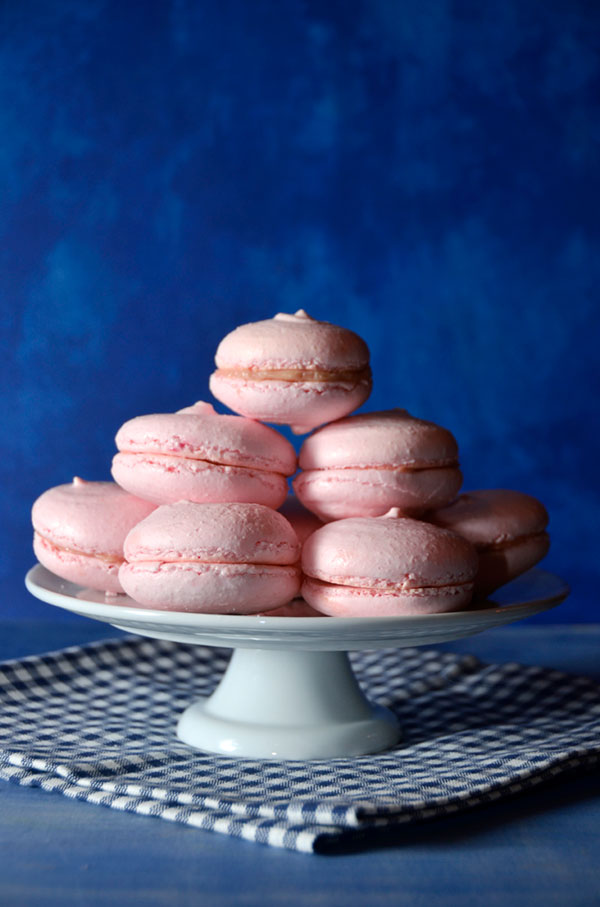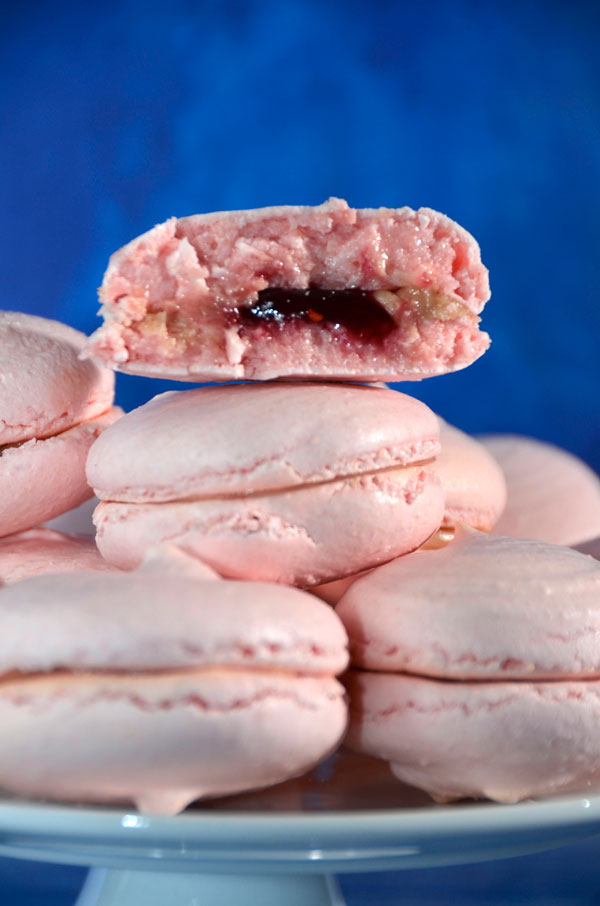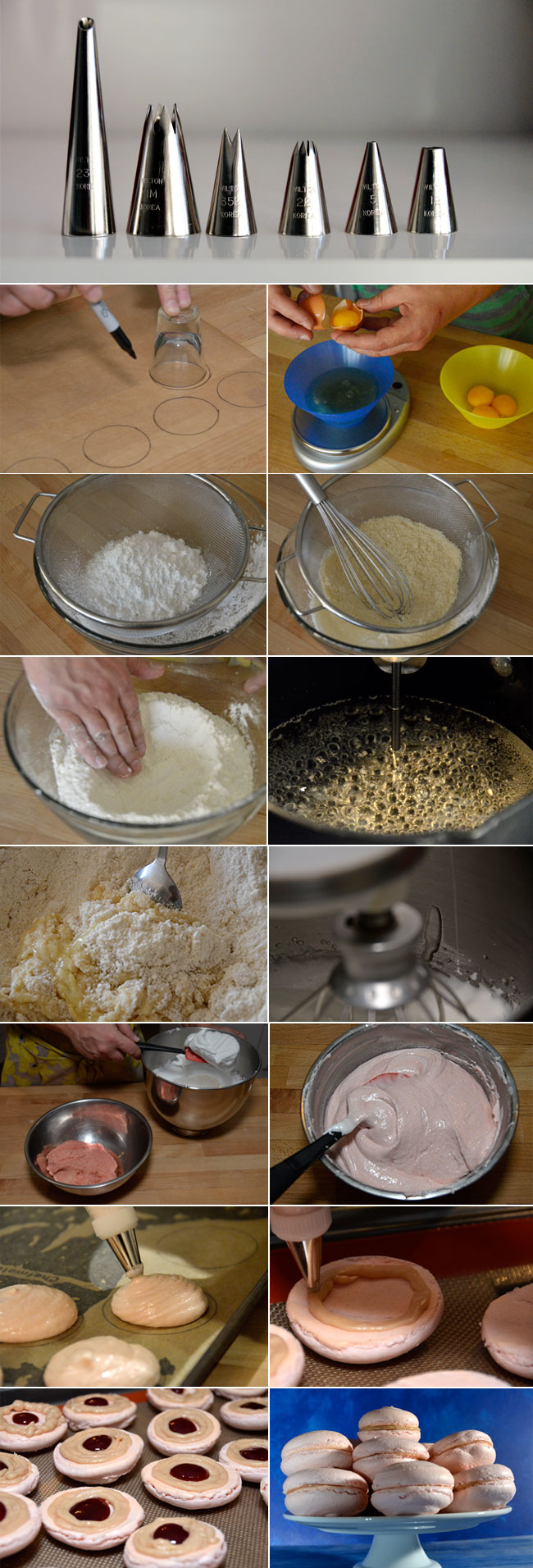Raspberry macarons: A recipe by Sebastien Rouxel and Thomas Keller
The latest Thomas Keller and Sebastien Rouxel book is called Bouchon Bakery, a visual celebration of sweets, pastries and breads at his famous bakery. The book has inspired us with new ideas and techniques and open new paths in our kitchen. With care, precision and love this book is part of our favorite collection and definitely will be part of many upcoming features in our cooking journal. We invite you to try this raspberry macaron recipe at home, you will love the results.
MACARONS
Almond flour/meal
212 grams | 1 3/4 cups + 2 1/2 tablespoons
Powder sugar
212 grams | 1 3/4 cups + 1 tablespoon + 2 teaspoons
Egg whites
82 grams | 1/4 cup + 1 1/2 tablespoons
90 grams | 1/4 cup + 2 tablespoons
Granulated sugar, plus a pinch for the egg whites
236 grams | 1 cup + 3 tablespoons
Water
158 grams | 2/3 cup
Chefmaster Liqua-Gel Rose Pink food coloring
3 – 4 drops
You will need a Thermapen or another candy thermometer, a pastry bag with a 1/2-inch plain tip, and a pastry bag with a 3/8-inch plain tip. Baking in a convention oven is preferable; the tops of the macarons baked in a standard oven often develop small speckles, which can affect the texture (though not the flavor)
For the macarons: Because the cookies will be sandwiched, it is important that they be as close in size as possible. Even if you are proficient with a pastry bag, we suggest making a template, as we do. Use a compass or a cookie cutter as a guide and dark marking pen, such as fine-tip Sharpie.
1. Lay a sheet of parchment paper. Trace 4 evenly spaced 2 1/4-inch circles along the top long edge, leaving 1 inch of space between them. Trace 3 circles below them, spacing them between the first circles. Continue with another row of 4, followed by another row of 3. Turn the parchment paper over and lay it on a sheet pan. Lift up each corner of the parchment and spray the underside with nonstick spray to keep it from blowing up while cookies are baking. Repeat with a second sheet pan and piece of parchment paper.
2. Preheat the oven to 350°F (convection) or 400°F (standard).
3. Place the almond flour in a food processor and pulse to grind it as fine as possible.
4. Sift the almond flour and powdered sugar into a large bowl and whisk together. Mound the almond flour mixture, then make a 4-inch well in the center, leaving a layer of the flour at the bottom. Pour in the 82 grams | 1/4 cup plus 1 1/2 tablespoons egg whites and combine with a spatula, stirring until evenly distributed. Set aside.
5. Place the remaining 90 grams/1/4 cup plus 2 tablespoons egg whites in the bowl of a stand mixer fitted with the whisk attachment. Combine the 236 grams | 1 cup plus 3 tablespoons granulated sugar and the water in a small saucepan and heat over medium-high heat until the syrup reaches 203°F/110°C.
6. Letting the syrup continue to cook, add the pinch of sugar to the egg whites, turn the mixer to medium speed, and whip to soft peaks. If the whites reach soft peaks before the syrup reaches 248°F/12o°C, reduce the speed to the lowest setting, just to keep them moving.
7. When the syrup reaches 248°F/120°C, remove the pan from the heat. Turn the mixer to medium-low speed, and slowly add the syrup, pouring it between the side of the bowl and the whisk; the meringue will deflate. Increase the speed to medium and whip for 5 minutes, or until the whites hold stiff, glossy peaks. Although the bowl will still be warm to the touch, the meringue should have cooled; if not, continue to whip until it is cool.
8. Fold one-third of the meringue into the almond mixture, then continue adding the whites a little at a time ( you may not use them all) until when you fold a portion of the batter over on itself, the “ribbon” slowly moves. The mixture shouldn’t be so stiff that it holds its shape without moving at all, but it shouldn’t be so stiff that it holds its shape without moving at all, but it shouldn’t be so loose that it dissolves into itself and does not maintain the ribbon; it is better for the mixture to be slightly stiff than too loose. Add 3-4 drops of food coloring into the finished meringue mixture and mix well.
9. Transfer the mixture to the pastry bag with the 1/2-inch tip. Hold the bag upright 1/2 inch above the center of one of the traced circles and pipe out enough of the mixture to fill in the circle. Lift away the pastry bag and fill the remaining circles on the first pan. Lift up the sheet pan and tap the bottom of the pan to the spread the batter evenly and smooth any peaks left by the pastry bag. If using a convection oven, bake for 8 to 10 minutes, until the tops and shiny and crisp. If using a standard oven, place the sheet pan in the oven immediately lower the oven temperature to 325°F, and bake for 9 to 12 minutes, until the tops are shiny and crisp. Set the pan on a cooling rack and cool completely. If using a standard oven, preheat it to 350°F again.
10. Pipe the remaining meringue mixture into the circles on the second sheet pan and bake as directed above. Let cool completely.
FRENCH BUTTERCREAM FOR FILLING
Makes 365 grams (1 2/3 cups)
Granulated sugar
38 grams | 3 tablespoons + 1/2 teaspoon
38 grams | 3 tablespoons + 1/2 teaspoon
Egg yolks
63 grams | 1/4 cup + 1/2 teaspoon
Whole milk
75 grams | 1/4 cup + 2 1/4 teaspoons
Unsalted butter, cut into 1/2-inch pieces, at room temperature
250 grams | 8.8 ounces
1. Whisk 38 grams/3 tablespoons plus 1/2 teaspoon of sugar and the yolks together in a medium bowl; set aside.
2. Combine the milk and the remaining 38 grams | 3 tablespoons plus 1/2 teaspoon of sugar in a medium saucepan, set over medium heat, and stir to dissolve the sugar. When the milk is at just below a simmer, remove the pan from the heat and, whisking constantly, pour it into the egg mixture. Return the mixture to the pan and place over medium heat. Whisking constantly, bring to a gentle simmer and simmer for 1 minute, lowering the heat if necessary to prevent the mixture from curling; it should be very thick.
3. Strain the mixture through a fine-mesh strainer into the bowl of a stand mixer. Fit the mixer with the whisk attachment, turn the mixer to medium, and whisk for 8 minutes, until the mixture is completely cool.
4. Add the butter, a few pieces at a time, to the egg yolk mixture. If at any point the mixture looks broken, increase the speed to re-emulsify it, the reduce the speed and continue adding butter. Check the consistency: if the butter cream is too loose to hold its shape, it should be refrigerated for a few hours to harder, then beaten again to return it to the proper consistency.
5. Add 50 grams | 2 tablespoons raspberry jam and mix for 1 minute, or until combined. If adding a jam center, use 80 grams | 3 1/2 tablespoons additional raspberry jam.
Be creative with buttercream flavors center. For example we like to make a peanut and jelly macaron. Peanut butter cream is piped around the edge and the center is filled with jam.
The butter cream can be stored in a container in the refrigerator for up to 5 days or frozen for up to 1 month; defrost frozen buttercream in the refrigerator overnight before using. Thirty minutes before using the buttercream, place it in the bowl of a mixer fitted with the paddle attachment and allow it to soften. Then mix on low speed to return the buttercream to the proper consistency for piping or spreading.
FOR THE FILLING
Place the French buttercream in the bowl of a stand mixer fitted with the paddle attachment and mix on medium-low speed until smooth and fluffy.
TO FILL THE COOKIES
1. Transfer the buttercream to the pastry bag with the 3/4-inch tip.
2. Remove the macarons from the parchment paper, turn half of them over. Starting in the center, pipe 15 grams | 1 tablespoon of the buttercream in a spiral pattern on one upside-down macaron, not quite reaching the edges. Top with a second macaron and press gently to spread the buttercream to the edges. Repeat with the remaining macarons and filling.
The macarons are best if wrapped individually in a few layers of plastic wrap and frozen for at least 24 hours or up to 2 weeks.. Defrost in the refrigerator for 3 hours, then bring to room temperature before serving. They can be served the day they are made or stores in a covered container in the refrigerator for up to 2 days.





No Comments